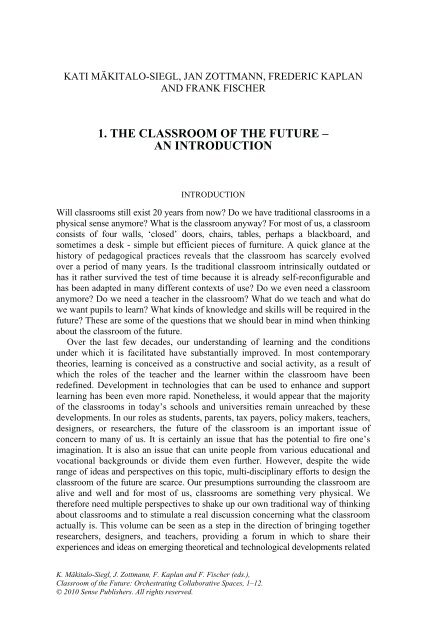Classroom of the Future - Sense Publishers
Classroom of the Future - Sense Publishers
Classroom of the Future - Sense Publishers
Create successful ePaper yourself
Turn your PDF publications into a flip-book with our unique Google optimized e-Paper software.
KATI MÄKITALO-SIEGL, JAN ZOTTMANN, FREDERIC KAPLAN<br />
AND FRANK FISCHER<br />
1. THE CLASSROOM OF THE FUTURE –<br />
AN INTRODUCTION<br />
INTRODUCTION<br />
Will classrooms still exist 20 years from now? Do we have traditional classrooms in a<br />
physical sense anymore? What is <strong>the</strong> classroom anyway? For most <strong>of</strong> us, a classroom<br />
consists <strong>of</strong> four walls, ‘closed’ doors, chairs, tables, perhaps a blackboard, and<br />
sometimes a desk - simple but efficient pieces <strong>of</strong> furniture. A quick glance at <strong>the</strong><br />
history <strong>of</strong> pedagogical practices reveals that <strong>the</strong> classroom has scarcely evolved<br />
over a period <strong>of</strong> many years. Is <strong>the</strong> traditional classroom intrinsically outdated or<br />
has it ra<strong>the</strong>r survived <strong>the</strong> test <strong>of</strong> time because it is already self-reconfigurable and<br />
has been adapted in many different contexts <strong>of</strong> use? Do we even need a classroom<br />
anymore? Do we need a teacher in <strong>the</strong> classroom? What do we teach and what do<br />
we want pupils to learn? What kinds <strong>of</strong> knowledge and skills will be required in <strong>the</strong><br />
future? These are some <strong>of</strong> <strong>the</strong> questions that we should bear in mind when thinking<br />
about <strong>the</strong> classroom <strong>of</strong> <strong>the</strong> future.<br />
Over <strong>the</strong> last few decades, our understanding <strong>of</strong> learning and <strong>the</strong> conditions<br />
under which it is facilitated have substantially improved. In most contemporary<br />
<strong>the</strong>ories, learning is conceived as a constructive and social activity, as a result <strong>of</strong><br />
which <strong>the</strong> roles <strong>of</strong> <strong>the</strong> teacher and <strong>the</strong> learner within <strong>the</strong> classroom have been<br />
redefined. Development in technologies that can be used to enhance and support<br />
learning has been even more rapid. None<strong>the</strong>less, it would appear that <strong>the</strong> majority<br />
<strong>of</strong> <strong>the</strong> classrooms in today’s schools and universities remain unreached by <strong>the</strong>se<br />
developments. In our roles as students, parents, tax payers, policy makers, teachers,<br />
designers, or researchers, <strong>the</strong> future <strong>of</strong> <strong>the</strong> classroom is an important issue <strong>of</strong><br />
concern to many <strong>of</strong> us. It is certainly an issue that has <strong>the</strong> potential to fire one’s<br />
imagination. It is also an issue that can unite people from various educational and<br />
vocational backgrounds or divide <strong>the</strong>m even fur<strong>the</strong>r. However, despite <strong>the</strong> wide<br />
range <strong>of</strong> ideas and perspectives on this topic, multi-disciplinary efforts to design <strong>the</strong><br />
classroom <strong>of</strong> <strong>the</strong> future are scarce. Our presumptions surrounding <strong>the</strong> classroom are<br />
alive and well and for most <strong>of</strong> us, classrooms are something very physical. We<br />
<strong>the</strong>refore need multiple perspectives to shake up our own traditional way <strong>of</strong> thinking<br />
about classrooms and to stimulate a real discussion concerning what <strong>the</strong> classroom<br />
actually is. This volume can be seen as a step in <strong>the</strong> direction <strong>of</strong> bringing toge<strong>the</strong>r<br />
researchers, designers, and teachers, providing a forum in which to share <strong>the</strong>ir<br />
experiences and ideas on emerging <strong>the</strong>oretical and technological developments related<br />
K. Mäkitalo-Siegl, J. Zottmann, F. Kaplan and F. Fischer (eds.),<br />
<strong>Classroom</strong> <strong>of</strong> <strong>the</strong> <strong>Future</strong>: Orchestrating Collaborative Spaces, 1–12.<br />
© 2010 <strong>Sense</strong> <strong>Publishers</strong>. All rights reserved.














